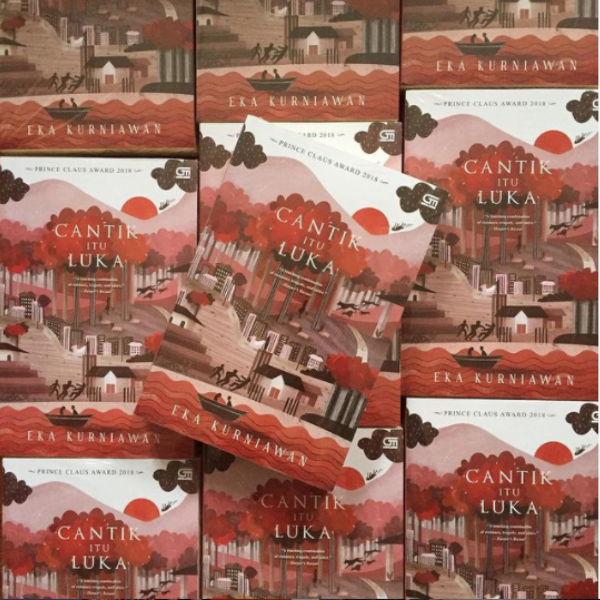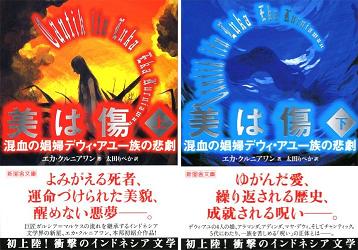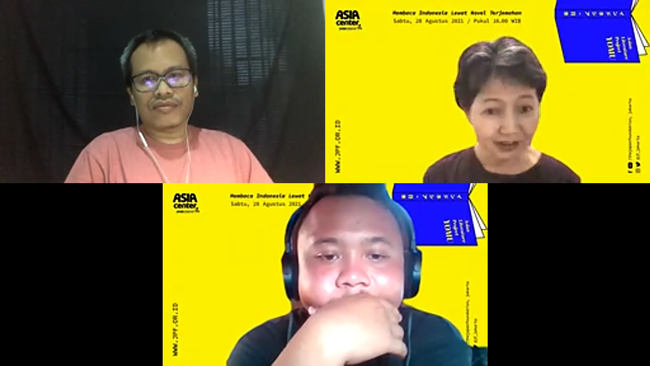Raka Ibrahim (hereinafter Raka): When you wrote Beauty is a Wound, what vision of Indonesia did you want to tell the world?
Eka Kurniawan (hereinafter Eka): Back then, I think I just wanted to present a big picture view of Indonesia. It was my first novel, I was young, and I was perhaps too ambitious. The next books were me realizing my age and limitations (laughs) There's a drive to write a novel that encapsulates Indonesia, the way Salman Rushdie spoke about India in Midnight Children, or how Gunter Grass spoke about Germany in The Tin Drum.

I was also heavily influenced by the writings of Pramoedya Ananta Toer*1 at the time. There was a deliberate attempt to pay tribute and move beyond him at the same time. When he wrote the Buru Quartet, Pramoedya chose The National Awakening and a few years before the Japanese Occupation as his timeline. I set my story right after—in the tail end of the occupation to the dying days of the New Order.
*1 Pramoedya Ananta Toer (1925-2006) was one of Indonesia's most celebrated authors. Imprisoned during the New Order regime for his left-leaning thoughts, his most famous work, The Buru Quartet, was composed during his stint in exile.
My thesis was about Pramoedya, so subconsciously I wanted to "beat" him. He ended his story before we became a nation, so I wanted to pick up where he left off. Indonesia in the womb, its birth, and its difficult childhood.
I wrote that novel in 2000 and published it in 2002, only four years after the Reformation*2. As a student, I studied for six years in Yogyakarta, and at least two years of my life were messed up because of the protests. That phase changed me as a writer and person.
*2 The Reformation refers to a period of democratization in Indonesia after the resignation of authoritarian president Suharto on 21 May 1998.
When I started writing a novel about Indonesia, my first question as someone who grew up during those times were: what kind of a nation could give birth to someone like Soeharto? I didn't mention him by name in the novel, but that was the primary question that drove me. My argument was that this was a country of violence. Since its birth, it was led from one violent act into another.
Raka: Why violence?
Eka: My image of Soeharto is one of violence. He was born into the Indonesian military tradition. And historically, it's often said that our military came from the people. Well, it's technically true. Since our struggle for independence, the revolutionaries were ordinary citizens who picked up weapons. Some became bandits, some organized themselves into armies.
This became a serious problem in the 1940s and 1950s, when [Then Vice-President] Mohammad Hatta had to fire many high-ranking members of the military. But the problem kept recurring. Psychologically, the Indonesian Army will always say that they came from the people and that they gave everything for the people. Therefore, it's only natural that they get involved in politics to protect the people.
This irked me when I wrote Beauty is a Wound. Since we were independent, we kept seeing a repeated pattern of violence. It's been fifty years—are we going to stay like this? Why can't we provide an alternative that's peaceful, a new dream for everyone? Even if my alternative won't change the world, at least these questions could change the minds of other people.
Raka: Ms. Ota, what were your thoughts when you first read Beauty is a Wound?
OTA Ribeka (hereinafter Ota): I found the first edition of the book in 2002. I didn't know anything about the book, but I thought the cover was interesting. When I read it, I was shocked. I didn't know Indonesia had a novel like this.
Older Indonesian writers like Pramoedya and NH Dini were more serious, morose, and spoke often on suffering, hardships, and poverty. They were dark writers. Beauty is a Wound was a heavy read, but it had a new perspective.
Raka: What was new about it?
Ota: I think the way Eka told the story was fresh. The main character, Dewi Ayu, was forced to be a prostitute for the Japanese army. But Eka wrote her differently than Pramoedya wrote about such characters in his book, Perawan Remaja di Cengkraman Militer (A Virgin in the Military's Grasp).
Pramoedya wrote like a witness retelling what he saw. It's important, it's meaningful, but Eka was unique because he took a step back from history. He saw it from an outsider's perspective, as if he had digested and spat out this tragedy, turning it into something new. I was fascinated by it.
Raka: Then came the idea of translating the book...
Ota: Yeah, I took initiative. I didn't have a publisher yet! (laughs)
Translating the book took three months, then I revised it after finding a publisher. I didn't have access to Eka at the time. When it became official, we got in touch and I asked him a million questions. Turns out I got a lot of things wrong! There was the internet, but back then it's not as easy or widespread. We spent a year finishing up the translation.

Bi wa Kizu: © Shinpusha
Raka: What challenges did you face when you translated Beauty is a Wound?
Ota: Foreign novels translated to Japanese would have a long translator's notes explaining the many specific terms or cultural references that can't be fully translated. Pramoedya's books had a long footnote after it was translated.
We wanted to do it differently. The book had to be enjoyed by anyone, even if they knew nothing about Indonesia, so we wanted as little notes as possible. Of course we still found untranslatable words, like becak [Indonesian rickshaw]. If you've never been to Indonesia, you won't know what that was.
We have a similar thing in Japan, rinta-ku. But Japanese rickshaws are pulled from the front, not pushed from the back like Indonesian becaks. I still chose rinta-ku to keep it simpler for Japanese readers, but I added becak next to it so people know that this is like a rinta-ku, but not exactly the same.
There are some sayings that I didn't fully understand. I knew the context behind the saying sama rata, sama rasa (same feeling, equal position) after the first edition was published, because I found the poem that first referenced this. So when the revised edition came out, I changed the translation a little bit.
Raka: Mr. Eka, were you worried that foreign readers won't catch the many cultural references in your book?
Eka: I wasn't too worried. I started writing with the assumption that Indonesians would read this, because there were a lot of references and inside jokes that only Indonesians would get. But I also realized that even Indonesians could miss it.
There were a lot of extremely specific references, too. In the book, the city of Halimunda celebrated Indonesia's independence on 23 September, not 17 August. Only one friend of mine would get that joke, and I don't mind confusing thousands of other readers as long as my friends laugh!
I also slipped in many historical references. Some characters mirrored the lives of real-life historical figures. Kamerad Salim, for example, was inspired by Musso, the communist leader of the Madiun Affair who allegedly died naked in a bathroom. Shodancho were inspired by Supriyadi, a PETA*3 soldier who allegedly were hand-picked by Soekarno to become Indonesia's military leader, before he was passed on in favor of Sudirman.
*3 PETA (Pembela Tanah Air, or Homeland Defense in English) was an Indonesian military unit formed by the Japanese government during the Japanese occupation. PETA veterans later formed the nucleus of Indonesia's national army.
These alleged histories and folklores are mine to play with. I wanted to retell their lives like comedians or people gossiping at the village. You don't get that in history books. Local folklore, gossip, history's footnotes—foreign readers might struggle with it, unless they also studied Indonesia extensively. But I don't mind.
Raka: Ms. Ota, you mentioned that this book wasn't a "witness' account" like other Indonesian novels you've read. Do you think this helped the book be accepted by Japanese audiences?
Ota: I think so. There's a litany of tales, stories, myths, and legends here. It's a rich retelling. Even though you're not Indonesian, or you're not familiar with the historical context, you can enjoy it as a story. It's something you can get lost into.
Eka: But this actually got me in trouble! (laughs) When it was published, I met a senior writer—let's keep them anonymous! —who complained because I messed around with history. The 1965 Tragedy*4 was sacred to them, and they said I wasn't sympathetic enough to the victims. He said I shouldn't joke around and write so coldly about it.
*4 The 1965 Tragedy refers to a period of civil unrest and genocide that occurred from 1965 to 1966. Civilians and politicians accused of harboring communist sympathies were massacred in a period of mass killings. An estimated 500 thousand to more than 1 million people perished.
But I disagreed. I was sympathetic, but I kept my distance from the incident. For me, we are a nation of wounds. But I'm part of that nation. And I would like to poke at those wounds, and even laugh at our own stupidity during those times. For the senior writer, this was disrespectful. But we have the right to view our history through different lenses.
Ota: These days, you see a new generation of Indonesian writers who write about history in a different way. Like Eka, they took a step back from history. They don't write "witness" novels written from the perspective of survivors or perpetrators.
Novels like Orang-Orang Oetimu (The People of Oetimu) by Felix K. Nesi wasn't written as a witness account, even though it speaks of a history of violence. But this history is digested and rewritten as something new. There's a different way of looking at things. Even though violence is real, it's already become a part of everyday life. Which, I suppose, is a social commentary in a different way.
Eka: Maybe older writers had a similar inclination to step back from history, but it's uncommon. Idrus spoke about the struggle for independence with humor and satire, not sadness. Pramoedya also slipped some irony in his novel, Perburuan (The Hunt). He tried to satirize an Indonesia that just wrestled its way into independence. He was asking, "Is this it? Is this independence? Killing each other, hunting each other?"
But his writing was still morose and contemplative. Today's writers would do it differently. If I wrote The Hunt, I would be much more cynical. I'd mock everyone.

Raka: Are you still obsessed with presenting Indonesia in a book?
Eka: It's always there, but it's not the same. These days I want to record an Indonesia that's smaller and more specific. I guess it's much more workable! (laughs)
I like to think of Beauty is a Wound as a carnival or festival. There are shows, spectacles, and rides to go on. But my next novels are more like small, intimate performances.
When I wrote Vengeance is Mine, All Others Pay Cash and O, I was celebrating 80s and 90s Indonesian pop culture. Silat stories, films and romance novels of the 80s, and the underground adult novels we read during those times.
In Beauty is a Wound, I was just copying the history books. It was mainstream, even though I tried looking at it differently. After that, I moved on. I wanted to see Indonesia from a different side.
Raka: Do you think Indonesian novels need to showcase this "local identity" so it can fascinate foreign readers?
Eka: I don't think so. If I read a Japanese novel, it doesn't mean I want to learn about Japan. I just wanted to know the story.
Next year, the short story collection Orang-Orang Bloomington (The People of Bloomington) by Budi Dharma will be translated by Penguin Classics. There's no Indonesia in his stories! (laughs) It's set in the United States, the characters are Americans. There's no keris, dangdut, or batik. You can't learn about Indonesia there, but his stories can be enjoyed by everyone.
Ota: The same applies for contemporary Japanese novels. MURAKAMI Haruki's works don't talk about Japan. The character's names are Japanese, but you can change it into European names and it won't mess with the story. Murakami doesn't have to showcase Japan in his stories. As long as the writer has a reality to tell, anyone can read it and be entranced.
Eka: The idea that we have to "write about Indonesia" is disturbing. I call it postcard-ism, a way of exoticizing ourselves to make us more palatable to international audiences. It's no different than the way the Dutch colonists portrayed "The Dutch East Indies" by showcasing traditional dances and keraton culture to the world. It's Indonesia, but presented in a deliberately exotic fashion.
Indonesian art isn't just Borobudur, Prambanan, keris, and batik. Everything Indonesian is part of our identity. Graffiti saying "I'm hungry!" is Indonesian, because that sentiment is contextual to Indonesia. We won't find Japanese street artists making such statements.
Ota: There are a lot of similarities between Indonesia and Japan these days. Our younger generation grew up on Doraemon and Nintendo. They even think alike. Maybe Indonesian youths are more religious, but on a day to day basis, we're not so different.
Eka: Japanese writers from the 20th century onwards—let's say, starting from Murakami's generation—see the world through a similar lens to Indonesian writers. That's the consequence of living in a globalized world. They read the same things, get angry about the same things. Only extremely localized problems make the difference.
Ota: Contemporary Japanese writers rarely write about Japan as a country or identity. They are more interested in personal narratives, small universes, and daily lives.
Raka: Which Indonesian writers do you think should be translated into Japanese? Conversely, which Japanese writers do you think should be translated to Indonesian?
Ota: I'm a big fan of Kura-Kura Berjanggut (The Bearded Turtle) by Azhari Aiyub, The People of Oetimu by Felix K. Nesi, and Gentayangan (Wandering) by Intan Paramaditha. They must be translated. As for Eka, I hope his novel O gets translated into Japanese soon.
Eka: There are three Japanese novelists who have caught my eye: KAWAKAMI Mieko, YU Miri, and TAWADA Yoko. Yu Miri's an interesting case. She was born in Japan, considers Japanese to be her mother tongue, and writes in Japanese. But, she's a South Korean citizen and her parents come from Korea. It's a unique situation.
Kawakami talks about a woman's world from a standpoint that's interesting for me as a man. Menstruation, breast implants, and other specific issues. Tawada Yoko is a great storyteller. It's like reading folklore.
One of Tawada's novels talks about a woman who married a dog. When I read it, I thought: "Wow, this is so similar to the legend of Sangkuriang in West Javanese folklore!" Then, the book's narrator admits they found this story from Southeast Asian folklore. I was shocked. It really is Sangkuriang! (laughs)
Ota: These days, American and European novels are more readily accepted by Japanese publishers and readers. If it's a hit in the U.S, it's going to get published here! But Indonesian books are more reliant on researchers and universities. The readership isn't large enough and the books aren't widely sold.
But once it's a hit, it'll be huge. A few decades ago, before Latin American literature got famous, most Japanese knew nothing about South America. But their literature was a hit with our readers. The same thing could happen to Indonesian literature. We just need brave publishers to make the breakthrough.






